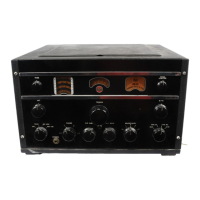Oper-
ation
No
Range
Switch
Position
Position
of
Dial
Generator
Frequency
Dummy
Antenna
Position
of Antenna
Trimmer
Trimming Adjustments for
Max.
Peak
Output
(See Figures 3 and
5)
Trimmer
Function
24 Repeat
22
and
23
until circuits remain in alignment over the band.
*2
j 5 Extreme low end 16,100 200 ohms L H
Low end osc.
High
end
~sc.
26 5 Extreme high end 22,700 200 ohms C27
27 Repeat
25
and 26 until extreme end frequencies are as indicated.
28
5'
22.500
k.c.
22,500 200 ohms Max. 'output C43, C66
1st
& 2nd
R,P
Ant.
& 1st
and
2nd
R-P
29
5'
16,400 k.c. 16,400 200
ohms.
. Untouched LW, L20,
130
30
Repeat
28
and 29 until circuits remain in alignment over the band.
*31
6 Extreme low end 22,000 200 ohms
156
Low end osc.
High
end osc.
32
6 Extreme high end
32,OQO
200 ohms C32
33
Repeat
31
and
32
until extreme end frequencies
are
as
indicated.
34 6
31,500 k.c. 31,500 200 ohms Max. output C45, C68
lst&2nd
R-P
Ant.
&>
lst
and 2nd
R,P
35
6 22,500 k.c. 22,500 200 ohms Untouched
Ll2,
L21,
L31
36
Repeat
34
and
35
until circuits remain
in
alignment over the band.
On
ull
bnud
..
tlte
oscillator
tr""ks
,IUO\'e
the
slgual
frequency.
It
mOTe
Iblln
one
Pellk
18
ohtnlll"ble
on
ollclUator,
use
tbe
b!gbf'r
frPlluellcy
petlk.
•
NOTE:
On
all
coils, except Nos.
4,
5,
and 6 band oscillator coils (LS4, LS5, and L56) turning the
Core
clockwise
in,
creases the inductance.
On
the above three mentioned coils, turning the core clockwise decreases the inductance.
Adjustment
of
Beat
Frequency OscUlator - Tune
in
a signal either R-P
or
I,F to exact resonance with
li'd'wer-Transmit,Receive Switch at ·'Rec. Mod" (Fig.
• )+
Turn
on beat frequency oscillator
by
turning
switch to "Rec.
CW."
If
zero beat does not fall within
the range of the BFO control. adjust BFO
Trimmer
L22
(see Pig. 5) until zero beat occurs
at
the
mid-point
setting of the
BFO control .
IX
MECHANICAL
CONSTRUCTION
The
receiver has been designed to be very rugged
so·
that
it
will stand up under severe conditions
of
&.se;
and yet have all parts available for easy replace'
ment, All component parts such as transformers,
~okes,
,~ter
and by'pass capacitors, etc., are mounted
with sctews and nuts rather
than
with rivets. All wir'
Ftg.othe.r:
than that involving high frequency circuits
"-:inade up in the form
of
a laced cable so that no
~e
leads are left floating which might
tause
damage
9:t'change capacity
to
various portions
of
the
circuit.
The
tuning condenser is mounted
so
as
to
be rigid
Wi~
respect
to
the tuning unit, ·and yet is flexible with
tespect
to
the chassis.
This
prevents distortion
of
the
chassis
from having any appreciable effect on the
atabilityof the oscillator.
The
R·F unit which consists of the tuning con'
denser.
tuning unit, range switch, and all
of
the R,F
~d
Oscillator coils and trimmers, is mounted on a
aeparate base-which bolts to the main base.
The
vari,
OUS
coils and trimmers on this base may be easily
replaced
by means of a single nut which screws on
the
iI1dividual mounting bushings. However
if
a
major
p~pair
is to be made such
as
replacement
of
the
range ·switch.
it
is necessary first to remove
the
com-
plete R-F unit from the receiver.
To
do this
the
follow'
ing procedure should be
observed:
1.
Remove the chassis and panel from the cab-
inet
by
removing the four panel mounting
13
screws and sliding the chassis forward
out
of
the. cabinet.
2.
Remove the knobs by means
of
the
small
wrench held in
the
spring clip. on
the
right
hand side of the chassis. This wrench
fits
the
set screws in all knobs except the main
tuning
knob. For this knob use an ordinary small
screw driver.
3.
Remove the panel
by
removing the eight nuts
with which
it
is held
to
the support brackets.
4.
Remove the large cover from
the
top
of
the
R,F unit, by removing the four knurled nuts
with
which
it
is supported.
5.
Remove the small cover
fro'm
the
tuning con·
denser, by removing the eight knurled
nuts
with which
it
is supported.
6.
Remove the dial light sockets where
they
a.re
dipped on to the tuning unit.
7.
Remove the antenna trimmer shaft extension
by loosening set screw in coupling with
same
wrench as used above for knobs.
8. Remove support bracket from flvwheel
tun'
ing shaft. ,
9.
Remove main dIal, vernier dial,
and
flywheel
by
loosening set screws with same wrench as
used
fJr
knobs.

